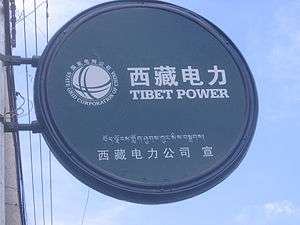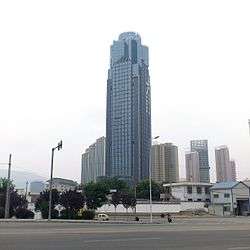State Grid Corporation of China
 | |
|
| |
| |
| State-owned enterprise | |
| Industry | Electric utility |
| Founded | 2002 |
| Headquarters | Beijing, China |
Area served |
China Philippines (through National Grid Corporation of the Philippines) Australia Brazil Italy |
Key people | Shu Yinbiao (President & CEO) |
| Products | Electrical grid, Electric power transmission |
| Services | Nuclear power transmission |
| Revenue |
|
|
| |
| Total assets | US$ 478.539 billion (2015)[1] |
| Total equity | US$ 207.345 billion (2015)[1] |
Number of employees | 927,839 (2015)[1] |
| Parent | State-owned Assets Supervision and Administration Commission |
| Website |
www |

The State Grid Corporation of China (SGCC; Chinese: 国家电网公司; pinyin: Guójiā Diànwǎng Gōngsī), commonly known as the State Grid, is the state-owned electric utility monopoly of China and the largest utility company in the world.[1] It is the second largest company by revenue in the world according to the 2016 Fortune Global 500 ranking. It has 927,839 employees, 1.1 billion customers and revenue of 329.6 billion dollars.[1][2]
After the electricity "Plant-Grid Separation" reform in early 2002, the assets of State Electric Power Corporation (国家电力公司) were divided into the five "power generation groups" that retained the power plants and five regional subsidiaries belonging to the State Grid Corporation of China in Beijing.[3] State Grid is the global leader in patent assignments in sustainable energy, highlighting an important trend for the organization.[4] The company is headquartered in Xicheng District, Beijing.[5]
History
China began an initiative to reform the country's power sector in a three-stage process in 1986.[6] In the third and final stage in March 2002 the State Council of the People's Republic of China put into effect a plan to restructure the country's electric power system in order to create competition and separate generation and transmission functions.[7] The State Grid Corporation of China was founded on December 29, 2002, when the restructuring divided the former State Power Corporation of China into two grid companies, five generation groups and four accessorial business companies.[8] The two grid companies created were the State Grid Corporation of China and a smaller China Southern Power Grid Company.[9] At its creation, the company had a generation capacity of 6.47 gigawatts.[7]
In 2003 and progressively so through the early 2000s, electrical shortages caused the government to institute rolling blackouts. The State Grid Corporation estimated there were 1 trillion yuan in losses from 2002 to 2005.[7] The State Grid Corporation of China ran the first 1,000-kilovolt alternating current power line between Northern Shanxi and center Hubei in January 2009. In 2012 it began operation of an 800-kilovolt direct current line that sends hydropower from western Sichuan to Shanghai. It also has an alternating current loop line in the Yangtze river delta, and three longitudinal alternating current lines that bring power to Southern China from the Northern region.[10]
The State Grid Corporation was involved in a multi-phase smart-grid project for China's electrical grid planned for 2011-2015.[11] China's smart grid efforts are different from those in the US in that its plans heavily use ultra high voltage (UHV) lines. Several UHV construction projects began in 2012 to bring UHV power lines across Huainan, Wannan, and Shanghai and another from Xilingol League to Nanjing. By 2015, the company plans to have three more horizontal UHV lines through West Inner Mongolia to Weifang, from Central Shanxi-Xuzhou to Yaan-southern Anhui and 11 other lines by 2015.[10]
In 2012 the company invested in CDP Reti.
Controversy
There have been several reports of corruption amongst a number of senior officials at the State Grid Corporation of China, with allegations of graft made. A number of these officials have stepped down as result.[12]
Overseas investments

On December 12, 2007, 2 consortia bid for a 25-year license to run the Philippines power grid - privatization of the management of the National Transmission Corporation (TransCo), the consortium of Monte Oro Grid Resources Corp., led by businessman Enrique Razon, comprising the State Grid Corporation of China, and Calaca High Power Corp., won an auction conducted by the Power Sector Assets and Liabilities Management (PSALM) Corp. as it submitted the highest offer of $3.95 billion, for the right to operate TransCo for 25 years, outbidding San Miguel Energy, a unit of San Miguel Corporation (bid of $3.905 billion), Dutch firm TPG Aurora BV and Malaysia’s TNB Prai Sdn Bhd.[13][14][15]
The resulting consortium became the National Grid Corporation of the Philippines (NGCP) which started its operations, management, and maintenance on TransCo's transmission facilities and assets on January 15, 2009 and the franchise will end on December 1, 2058.
In Australia, State Grid owns a 41% stake in ElectraNet, a 19.9% stake in AusNet Services, and 60% stake in Jemena.[16]
Subsidiaries
- State Grid Yingda Group
- Yingda International Trust (89.76%)
See also
References
- 1 2 3 4 5 6 7 "State Grid". Fortune Global 500. Retrieved 29 April 2017.
- ↑ JamesPaton14, James Paton. "China Builds an Empire of Electricity With Australia as Target". Bloomberg.com. Retrieved 2016-08-11.
- ↑ JamesPaton14, James Paton. "China Builds an Empire of Electricity With Australia as Target". Bloomberg.com. Retrieved 2016-08-11.
- ↑ "Resolute Innovation". resoluteinnovation.com. Retrieved 2017-07-27.
- ↑ "Contact Us." "State Grid Corporation of China. Retrieved on July 8, 2010.
- ↑ Gee, Robert; Songbin Zhu; Xiaolin Li, China's power sector: Global economic and environmental implications
- 1 2 3 The Xinfeng Power Plant Incident and Challenges for China's Electric Power Industry (PDF), IEEJ, February 2007, retrieved 10 October 2012
- ↑ Chen Wenying (2006). China's Energy Outlook. Guida Editori. ISBN 978-981-256-748-2. Retrieved 10 October 2012.
- ↑ China’s power sector revolution stalled, October 14, 2010, retrieved October 10, 2012
- 1 2 China grid eyes building 2 new UHV power lines this yr, Reuters, August 13, 2010, retrieved 2012-10-10
- ↑ Bojanczyk, Kamil (October 9, 2012), Reprint: China and the World’s Greatest Smart Grid Opportunity, GreenTech Media, retrieved 2012-10-10
- ↑ "State Grid Shanghai chief Feng Jun detained in corruption sweep".
- ↑ Manila Times, RP-China group wins $3.95-B TransCo bid
- ↑ Editorial, Reuters. "Two groups vie for multi-billion dlr Manila power deal".
- ↑ Abs-Cbn Interactive, Monte Oro consortium wins TransCo bidding
- ↑ Maiden, Malcolm. "China's State Grid powers up in Australia". Retrieved 2016-08-11.
External links
- Official website
- Official website (in Chinese)
